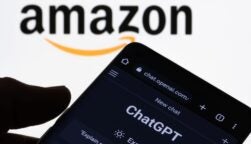Amazon proudly announced last week that it was acquiring Zoox, a self-driving startup. The deal was reported to be worth around $1.2 billion.
However, just three days later, Amazon warehouse staff in Germany went on strike to protest the lack of protective equipment they have been given from coronavirus.
How can a company that has pockets so deep, offer so little to its most vulnerable workers?
Amazon’s Coronavirus Response
While many businesses have struggled to stay open during the coronavirus pandemic, Amazon has been making money hand-over-fist. In fact, its stock price has rocketed since the start of 2020.

Amazon stock price chart, click to expand. Source: Yahoo!finance
Despite its increasing profits, Amazon has been reluctant to spend its new money on protecting the workers in its fulfilment centers – even after employees have reported being infected with coronavirus.
“Amazon has so far shown no insight and is endangering the health of employees in favor of corporate profit,” said Orhan Akman, who is responsible for the retail and mail order business at German union ver.di.
“Everything the union demands is already in place: wages at the upper end of what is paid for similar jobs, career opportunities and a safe working environment,” said Timothy Carter, a spokesman for Amazon.
“The union has called for strikes in six German fulfilment centers,” Carter continued. “The majority of our associates do not participate and we see no impact on customer orders. The fact that more than 8,000 of our over 13,000 permanent associates in Germany have been with us for more than 5 years proves that we are a fair employer.”
Amazon’s Coronavirus Initiatives
Amazon told us that, “by the end of June,” it had “invested approximately $4 billion worldwide on COVID-related initiatives getting products to customers and keeping employees safe.” In Germany alone, it had “ordered 470 million units of hand disinfectant, 21 million pairs of gloves, 19 million units of face masks, face shields and other mouth-nose-covers, 39 million units of disinfectant wipes.
It also said that “health authorities and government officials are confirming that we have the right measures in place to protect associates and customers.”
It’s widely observed that coronavirus spreads faster and further when indoors, and with Amazon’s fulfilment centers resembling a “prison or an airport” it seems these could be the perfect breeding ground.
Even if these protections are in place, there are still a host of problems for the workers in Amazon’s fulfilment centers.
Ver.di has criticized the company for refusing to lower its infamous product picking targets. The union said that wearing a face mask makes it harder for employees to breathe, which would slow down their work.
The issues aren’t limited to productivity, however. “The main problem is the lack of transparency, meaning workers don’t know if there’s any problem in a fulfilment centre,” said André Scheer, trade union secretary at ver.di. “When colleagues disappear, are they ill or in quarantine?”
Amazon had this to say:
“Nothing is more important than the safety of our teams. We have redeployed a large number of our data scientists, technologists, and operations employees to focus on COVID-19 and ensure the safety of our workforce, including thousands of individuals on our health and safety teams. An in-depth analysis of sites is one of many tools that help us evaluate the full picture in our buildings related to COVID-19. In addition to a deep dive by a site, other tools include social distancing audits and having an epidemiologist review available data to ensure our safety measures are effectively protecting workers from exposure to COVID-19 in the workplace.”
The Danger of Speaking Out
Particularly concerning, however, has been Amazon’s response to other strikes regarding the lack of coronavirus in its warehouses around the world.
Back in April, Amazon was quick to fire Chris Smalls and Bashir Mohamed, of New York and Minnesota, respectively, who led striking warehouse employees. It also fired UX designers Emily Cunningham and Maren Costa who were planning to lead an online walkout for office-based employees in solidarity with their warehouse colleagues.
Read more – Amazon’s Controversial Response to Coronavirus Continues
“We utilize a variety of data to closely monitor the safety of our buildings and there is strong evidence that our employees are not proliferating the virus at work,” said Amazon’s Timothy Carter. “What we see generally is that the overall rate of infection and increase or decrease of total cases is highly correlated to the overall community rate of infection. Over the months of COVID-19, thousands of employees and partners have worked at our Shakopee [MN] site and we believe strongly people are not spreading the virus at work given the robust safety measures we’ve put into place.”
It’s unclear at the moment if anyone has been reprimanded by Amazon higher-ups in Germany for the strike, which started on Monday. However, Germany is known for its powerful labor unions, so Amazon would likely face some backlash if it tried to fire workers over the strikes.
The Zoox Purchase
Of course, the backdrop to all this is Amazon’s purchase of Zoox.
“Zoox is a forward-thinking team that is pioneering the future of ride-hailing by designing autonomous technology from the ground up with passengers front-of-mind,” read Amazon’s statement.
Zoox will also continue to operate as a standalone business, retaining its CEO and CTO and current staff. According to the Financial Times, the deal is worth around $1.2 billion.
However, despite Zoox managing to raise around $950 million of venture capitalist funding as of October last year, it was forced to layoff 120 employees — around 10% of its total headcount in — April. This is after it hired Aicha Evans from Intel to help push the company towards commercialization last January.
Amazon’s decision to buy a company that doesn’t look like it’s going anywhere in a hurry – while also failing to protect its workers in an unprecedented crisis – looks negligent at best and callous at worst.
Update 7/2/2020: Statements from Amazon inserted.
Lead image credit: DPA




